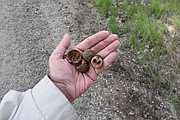Black walnut tree, a tough nut to crack!
“There rises the moon, broad and tranquil, through the branches of a walnut tree on a hill opposite.”
— Henry Wardworth Longfellow (Feb. 27, 1807 — March 24, 1882)
This last spring I observed several black walnut trees near the Kootenai River. At first glance I was impressed with the stately trees as I sat still listening to the caws of the early morning crows and watching a hawk glide over the fields and grasslands. I didn’t recognize the species of the trees until I walked around them and saw the black walnuts that had fallen from the branches last fall. I wondered how old this magnificent tree was and the changes it had experience over the years.
As I discovered, the black walnut tree is one of North America’s most valuable and beautiful native trees. The easily worked, close-grained wood of the black walnut has long been prized by furniture and cabinet makers for its attractive color and exceptional durability.
The early settlers discovered black walnuts growing in mixed forests from Canada to northern Florida and west to California. They found that its rich-brown hardwood was exceptionally resistant to decay and put it to use as fence posts, poles, shingles and window sills.
Walnuts are specifically deciduous trees, 30 to 130 feet tall with pinnate leaves containing five to 25 leaflets. The actual leaf is attached to twigs in a mostly alternate arrangement and the leaf structure is odd-pinnately compound, meaning that the leaves consist of an odd number of individual leaflets that attach to a central stem. These leaflets are serrated or toothed. The shoots and twigs have a chambered-pith, a characteristic that can quickly confirm the tree’s identification when a twig is cut open. The fruit of a walnut is a rounded, hard shelled nut.
Black walnut trees (Juglan nigra) are part of the general plant family Juglandaceae, which includes walnuts as well as hickory trees. The Latin name, Juglans, derives from Jovis glans, “Jupiter’s acorn” — figuratively, a nut for a god. There are 21 species in the genus that range across the north temperate Old World from southeast Europe east to Japan, and more widely in the New World from Southeast Canada west to California and south to Argentina.
Grey in color, walnut tree bark is rough and full of deep ridges and valleys. These ridges run vertically up and down the tree trunk and have rounded edges. If you remove a piece of bark from the tree, you’ll find a rich, deep chocolate brown color hiding beneath the tree’s gray exterior. The bark is especially helpful in identifying walnut trees in the winter when they’ve dropped their leaves and aren’t producing walnuts.
The nuts on a walnut tree won’t look like the ones you find in the grocery store, however. The nut itself forms in a brown, textured shell that you can crack open with a nutcracker. On the tree, however, the brown outer shell is covered by green casing reminiscent of a small tennis ball. This outer hull is extremely tough and difficult to crack — so much so that a common way of opening them is to line them up in the driveway and drive over them a few times with a car!
If you’re lucky enough to have a walnut tree, now is the time your work begins with the drying and harvesting process.
Enjoy Boundary County and its beautiful trees.



